
Izatha is a genus of moths of the family Oecophoridae. They are commonly known as lichen tuft moths. This genus is endemic to New Zealand.

Izatha attactella is a moth of the family Oecophoridae. This species is endemic to New Zealand, where it is known from both the North and South Islands as far south as mid-Canterbury. Larvae of this species feed on the soft inner surface of the bark of dead trees and shrubs. Adults have been recorded from September to December.
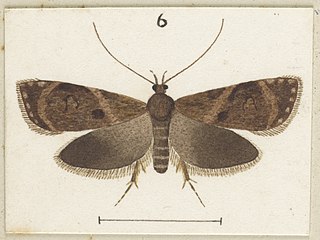
Izatha austera is a species of moth in the family Oecophoridae. It is endemic to New Zealand. The larvae of this species feed on dead wood by tunnelling into branches of its host species. The larvae matures from September and is on the wing in the months of December to January. The adult moth is variable in colouration but is seldom observed.

Izatha psychra is a species of moth in the family Oecophoridae. It is endemic to New Zealand. It is classified as Nationally Endangered by the Department of Conservation. In 2020 it was feared that this moth was extinct as a result of a fire at the Pukaki Scientific Reserve, the last known locality of this species. However a 2021 survey found I. psychra present in the small portion of the reserve that was not damaged by the fire.

Izatha copiosella is a moth of the family Oecophoridae. It is endemic to New Zealand, where it is found on the south-eastern parts of the North Island and throughout the South Island except the West Coast. Larvae are found in dead wood and are likely to use kōwhai species as hosts. The adults are night fliers and are attracted to light. They are on the wing in January and February.

Izatha apodoxa is a moth of the family Oecophoridae. It is endemic to New Zealand, where it is known from scattered localities in the southern North Island. This species is variable in appearance and comes in two forms, a grey form and a black and white form. In the grey form it is very similar in appearance to I. notodoxa and in the black and white form to I. katadiktya. At present the larvae and biology of this species is unknown.

Izatha metadelta is a moth of the family Oecophoridae. It is endemic to New Zealand, where it is known from the North Island only. It is rare north of Waikato and the Bay of Plenty.
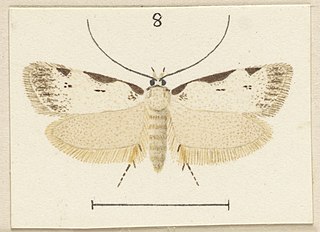
Izatha balanophora is a moth of the family Oecophoridae. It is endemic to New Zealand, where it is widespread in the North Island. Larvae live off the dead bark of kānuka. The adult moths are on the wing during December to March.

Izatha mesoschista is a moth of the family Oecophoridae. It is endemic to New Zealand.
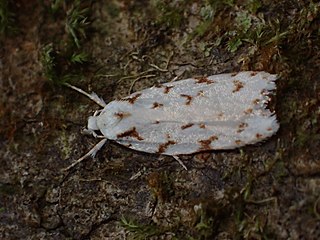
Izatha hudsoni is a species of moth in the family Oecophoridae. It is endemic to New Zealand. It is widespread throughout the North Island.
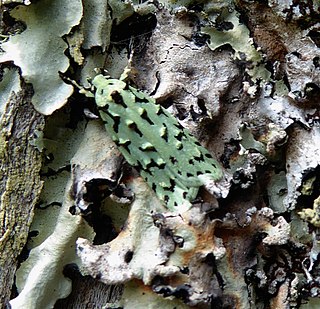
Izatha peroneanella, also known as the small lichen moth or the green lichen tuft, is a moth of the family Oecophoridae. It is endemic to New Zealand, where it is found throughout the North Island, other than the Aupouri Peninsula of Northland.

Izatha prasophyta is a moth of the family Oecophoridae. It is endemic to New Zealand, where it is known from the North Island, except Hawkes Bay or the Wairarapa. Larvae likely feed on rotting wood although larvae of this species have been reared on the fruiting body of the bracket fungus Bjerkandera adusta. Adults are on the wing from November to February.

Izatha caustopa is a lichen tuft moth in the family Oecophoridae. It is endemic to New Zealand, where it is known very locally, and very infrequently, from the southern half of the North Island: two specimens collected in 2016 were the first seen for 30 years. It is classified as "Data Deficient" by the Department of Conservation.
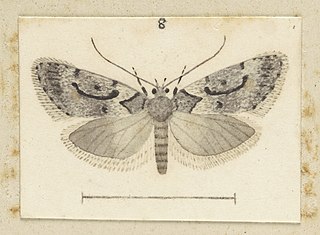
Izatha manubriata is a moth of the family Oecophoridae. It is endemic to New Zealand, where it is known from the southern South Island only.

Izatha rigescens is a species of moth in the family Oecophoridae. It is endemic to New Zealand. This species is classified as having the conservation status of "Data Deficient" by the Department of Conservation. It is only known from the Wellington coast. This species has not been seen since 1929.
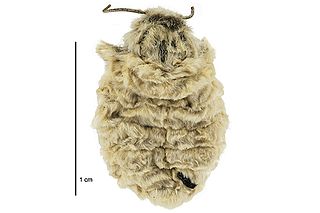
Metacrias huttoni is a species of moth in the family Erebidae. This species is endemic to New Zealand where it is known from the eastern areas of the South Island. The female of the species is flightless and buff coloured where as the male is brightly coloured and flies during the day.

Austramathes purpurea is a species of moth in the family Noctuidae. It is endemic to New Zealand and can be found throughout the North and South Islands but has yet to be recorded at Stewart Island. It inhabits native forest. This species might possibly be confused with A. pessota, however this latter species does not have the purple hue to the forewings. The larvae of A. purpurea feed primarily on māhoe but have been recorded as feeding on, and have been reared on, narrow-leaved māhoe. The larvae pupate in a silken cocoon on moss covered ground. Adults can be found on the wing during the months of March to January but mainly occur during New Zealand's late autumn, winter, and spring. Light trapping may not be the most efficient technique for collecting this species.

Austrocidaria anguligera is a species of moth in the family Geometridae. It is endemic to New Zealand. It is regarded as being uncommon but is frequently confused with Austrocidaria bipartita.

Ichneutica virescens is a moth of the family Noctuidae. It is endemic to New Zealand, and is found in the southern North Island and throughout the South Island. The species is found in alpine, sub-alpine, and down to sea-level in grassland habitats. Adults are on the wing from November through to April. The likely larval host may be grasses, but larvae have been reared on a range of plants. The adults are similar to I. panda, I. falsidica and I. nobilia, but is distinguished by size, wing colouration, and antennae formation.
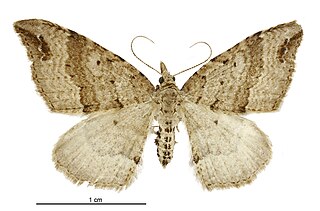
Homodotis falcata is a moth of the family Geometridae. It is endemic to New Zealand and is found in the southern part of the South Island. The larvae of this species feed on leaf litter and adults are on the wing for most months of the year. The forewings of this species can vary in depth of colour.





















